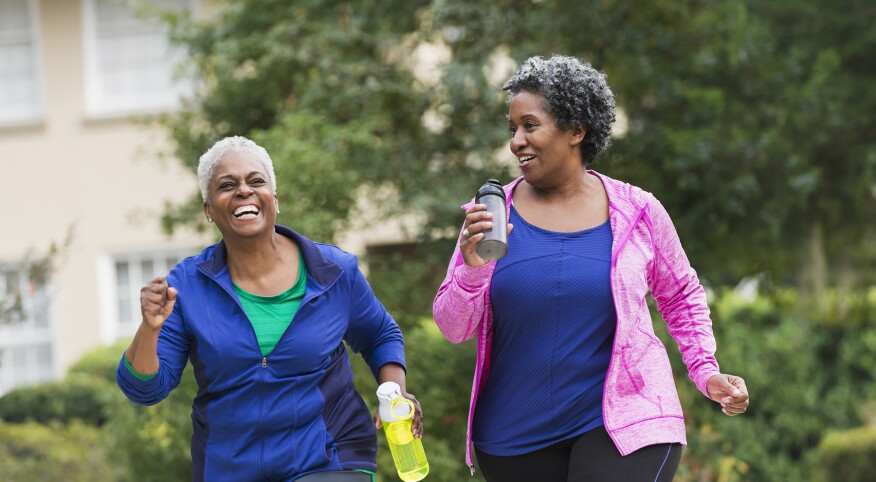After you eat a snack or a big meal, it’s tempting to just sink into a chair and relax, especially at the end of a long day. The longer you sit, the more likely you are to reach for a second helping or dessert. But getting up and getting active instead, even for just a few minutes, could have a profound effect on your health.
Your mother probably told you that taking a walk after eating is good for digestion and clearing your head. Now researchers have found that taking a short stroll after a meal can also help lower blood sugar, a factor in type 2 diabetes. “Walking is great,” says Theodore C. Friedman, M.D., Ph.D., a professor at Charles R. Drew University of Medicine and Science. “I recommend it to my patients a lot because they can do it 24/7, [and] they don’t need a special location or special equipment. They just go out and walk.”
Even a short walk of two to five minutes can trigger the blood-sugar-lowering effect and other health benefits. The more you walk, the better. Research shows that the effect walking has on blood sugar is greatest within 60 to 90 minutes after a meal.
How does it lower blood sugar? Dr. Friedman explains that when you are physically active after eating, your body breaks down a type of sugar called glycogen. Instead of being stored as fat, that glycogen fuels your muscles, and your blood sugar goes down.
The good news is it doesn’t take much activity to have an impact. Even a short walk of two to five minutes can trigger the blood-sugar-lowering effect and other health benefits. The more you walk, the better. Research shows that the effect walking has on blood sugar is greatest within 60 and 90 minutes after a meal.
Because African Americans have a higher risk of diabetes and complications from the disease, especially as we age, mini walking is the type of habit we need to pick up. How can you get the most out of this walking cure? Invest in some comfortable walking shoes and try these tips:
Schedule walking breaks. If you work in an office, plan to take short breaks during the day to get up and visit the water cooler, walk the halls or simply stretch your legs. Try to get up every half hour or so, Dr. Friedman says. Set a timer or put walking on your calendar, if that helps.
Take advantage of telecommuting. If you have the option of working from home one or more days a week, be sure to walk on those days. Use the time you would otherwise be commuting to take a quick stroll after breakfast, for example, or walk your dog after lunch. At home, you have fewer interruptions and more flexibility to move your body after a meal.
Use lunchtime wisely. Whether you have a half hour or an hour for lunch, spend part of that time walking. “If you’re eating your lunch, add an extra five minutes to your lunch break and spend time walking,” Dr. Friedman says. Or if you have a full hour, eat for 15 minutes and go for a walk for up to 45 minutes, he suggests.
Add up your time. If you only have time for a five-minute walk to the office coffeepot or around the block, try to take those five minutes four times a day. “That’s 20 minutes,” Dr. Friedman says. “It’s cumulative.” On weekends, start with 20 to 30 minutes and add from there.
Keep it moving. Stop by a coworker’s office or desk instead of sending an email or picking up the phone. Take the stairs instead of the elevator. The more movement, the better for managing blood sugar throughout the day. Getting up more frequently may also help you avoid an achy back or stiff joints caused by all-day sitting, Dr. Friedman says.
Go outside. If weather permits and you have the option, take your walk outdoors. There are multiple benefits besides the positives for your blood sugar and heart. “Sunlight helps your mood,” Dr. Friedman says. “It’s a way to get your vitamin D naturally.”
Try walking meetings or groups. If appropriate, invite a colleague for a walk-and-talk outdoors instead of a virtual or sit-down meeting. Or start a walking group for the company and motivation.
Invest in a standing desk. Standing instead of sitting after eating is also good for you. “It burns more calories to stand than to sit,” Dr. Friedman says. The standing desk can be moved up or down during the workday. When you can’t get away for a walk, you can lift the desk up to engage your muscles instead of sitting all day.
Create an after-dinner tradition. Solo or with your family, make it a new routine to take a walk after dinner. Supper is often the biggest meal, and evening can be the best time to walk it off. It will help your body avoid or manage blood-sugar spikes, and it might even improve your sleep.











